Atlantic Monthly Contributors's Blog, page 115
July 24, 2016
Exit, Debbie Wasserman Schultz

NEWS BRIEF Debbie Wasserman Schultz has resigned as the chair of the Democratic National Committee (DNC) following a leak of thousands of emails that appeared to show committee staffers favoring Hillary Clinton over Bernie Sanders for the party’s presidential primary contest.
The Florida congresswoman said in a statement Sunday she will step down from the job at the end of the Democratic National Convention, which begins Monday in Philadelphia.
“I know that electing Hillary Clinton as our next president is critical for America’s future. I look forward to serving as a surrogate for her campaign in Florida and across the country to ensure her victory,” she said. “Going forward, the best way for me to accomplish those goals is to step down as party chair at the end of this convention.”
Donna Brazile, the DNC’s vice chair, will serve as interim chair through the election, the committee announced on Twitter.
Wasserman Schultz’s resignation comes days after the leak was reported Friday. The trove of nearly 20,000 emails, obtained by the hacker known as Guccifer 2.0 and shared with and published by WikiLeaks, seemed to show Democratic staffers discussing how to shrink support for the Sanders campaign. One email from May 2016 suggested using the Vermont senator’s religious background as ammunition.
“It might may no difference, but for KY and WVA can we get someone to ask his belief,” wrote one staffer to three others. “Does he believe in a God. He had skated on saying he has a Jewish heritage. I think I read he is an atheist. This could make several points difference with my peeps. My Southern Baptist peeps would draw a big difference between a Jew and an atheist.”
“AMEN,” one of the recipients responded.
Sanders staffers were outraged, and said the emails confirmed their suspicions throughout the primary cycle that the DNC was favoring Clinton over Sanders.
In May, Sanders wrote Wasserman Schultz a letter expressing his disappointment with her choosing three of 45 people the senator had recommended to serve on standing committees at this month’s convention, suggesting Clinton was given more representation at the event. “If we are to have a unified party in the fall, no matter who wins the nomination, we cannot have a Democratic National Convention in which the views of millions of people who participated in the Democratic nominating process are unrepresented in the committee membership appointed by you, the chair,” Sanders wrote.
After Wasserman Schutlz announced her resignation Sunday, Sanders said in a statement the congresswoman “made the right decision.”
“While she deserves thanks for her years of service, the party now needs new leadership that will open the doors of the party and welcome in working people and young people,” he said. “The party leadership must also always remain impartial in the presidential nominating process, something which did not occur in the 2016 race.”
Wasserman Schultz became DNC chair in May 2011, taking over from Tim Kaine, who is now a Virginia senator and Clinton’s newly announced pick for vice president. Rumors of her resignation had intensified Sunday morning, after her speech this week as convention chair in Philadelphia was canceled, NPR reported.
Clinton thanked Wasserman Schultz in a statement Sunday. “There’s simply no one better at taking the fight to the Republicans than Debbie—which is why I am glad that she has agreed to serve as honorary chair of my campaign's 50-state program to gain ground and elect Democrats in every part of the country,” she said.
President Obama said in a statement he spoke with Wasserman Schultz by phone Sunday about her resignation. Obama said the congresswoman “has had my back” during his presidency, and that “her leadership of the DNC has meant that we had someone who brought Democrats together not just for my re-election campaign, but for accomplishing the shared goals we have had for our country.”

Russia Goes to Rio
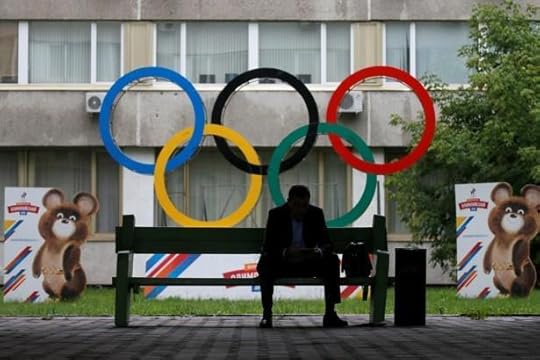
NEWS BRIEF Russia will not be banned from the Olympic Games in Rio de Janeiro next month following the country’s doping scandal, the games’ committee has announced.
The International Olympic Committee said in a statement Sunday it would leave the decision to accept Russian athletes at Rio to international federations, or the governing bodies, of their respective sports.
Earlier this month, an investigation commissioned by the World Anti-Doping Agency found Russia had operated a state-sponsored doping program between 2011 and 2015, during summer and winter Olympic games, including the 2014 tournament the country hosted in Sochi. Top Olympics officials had gathered to deliberate the fate of Russian athletes at this year’s games.
The committee on Sunday placed the blame on the Russian government for the scandal. “All Russian athletes seeking entry to the Olympic Games Rio 2016 are considered to be affected by a system subverting and manipulating the anti-doping system,” the statement said.
The committee said all Russian athletes participating in the games have been tested by foreign anti-doping agencies over the last six months. Of the more than 3,000 doping samples collected, “the vast majority” tested negative for performance-enhancing drugs.

Aleppo's Besieged Hospitals

NEWS BRIEF Air strikes hit five hospitals and one blood bank in the northern province of Aleppo Sunday, the site of intense violence in Syria’s five-year-long civil war.
The strikes came from government forces, according to the AP, which cited Syrian opposition activists. A Syrian rescue group also said on Twitter six medical facilities had been struck.
The strikes targeted Aleppo, the province’s rebel-held capital, and Atareb, a nearby town. The number of casualties and injured is not yet clear.
More from AP:
Aleppo-based activist Baraa al-Halaby told the AP that five clinics were hit, adding that an infant was killed in a clinic in the Shaar neighborhood in the early hours of Sunday.
The International Committee of the Red Cross in Syria confirmed the news on Twitter. “Harrowing news: More hospitals hit in #Aleppo this morning,” it said. “Civilians and hospitals are #notatarget.”
Hospitals and other medical facilities have for months been caught in the crossfire in the conflict between the Syrian government and rebel groups. Dozens of patients, doctors, and hospital staff have been killed. In April, an air strike destroyed a hospital in Aleppo, killing dozens, including patients, doctors, and one of the last remaining pediatricians in the city.

The Man Who Captured Time
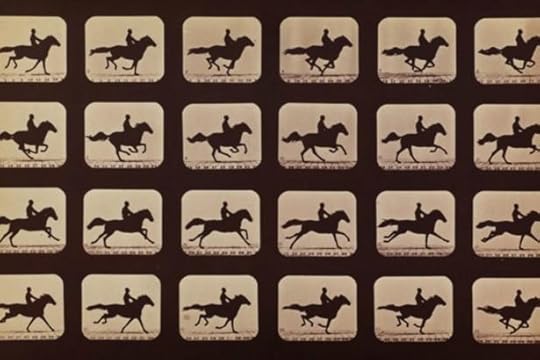
The first humans who put paint on stone drew deer, buffalo, horses. They drew all the beasts man knew, and they painted them running.
It started on a cave wall in France some 40,000 years ago with animals that seemed to move with their hindquarters planted, torsos rigid, their front legs stiff and raised ever so off the ground. These Paleolithic artists were primitive, of course, but for the thousands of years to follow, neither the ancient Greeks, nor Leonardo Da Vinci, nor the Japanese masters, nor the 19th-century French artist Jean-Louis-Ernest Meissonier (regarded for his pictures of horses) could seem to understand how to draw an animal in motion.
Especially horses. Even as humans increasingly spent their lives around horses, the greatest artistic talents of their time drew them running with all four legs splayed, as if mounted to a rocker. Man has always sought to understand the natural world—if for no other reason than to bend it to our will. But an invisible life existed in the motion of the horse, hidden from our eye, and thus from human understanding. Until the 1870s, when the man who founded Stanford University became obsessed with this mystery—so much so that he hired the photographer Eadweard Muybridge.
The galloping horse became Muybridge’s greatest achievement, but it would also become as obscure as his many other accomplishments. As he neared death, it’s said Muybridge panicked over the idea he’d be forgotten. And he almost was. No major museums had staged a retrospective of his work until six years ago at the Corcoran Gallery of Art, when the curator Philip Brookman thought to put one together, partly because no one else had. Last month, the National Gallery of Art (which absorbed the Corcoran in 2014) presented Intersections, which offers another chance to consider Muybridge’s mind and his legacy, and to see the work of another 19th-century pioneer of photography, Alfred Stieglitz.
In its earliest years, photography rode an unsure line between science and art. It transported facts of the world to the public. It offered pretty images. Few people knew what to do with it. But Muybridge and Stieglitz changed that.

Eadweard Muybridge
Stieglitz was an artist, born in Hoboken and trained in Berlin, who proved photos could tell stories and reveal the world as profoundly as paintings. Muybridge’s work, at first, concerned itself with questions of understanding––a mostly scientific pursuit. He was born to an English coal merchant, and at 20 he left for America, where he traveled west in search of success in the new country. In California he opened a bookstore, was absolved of killing a man, then busied himself with photographing the intricacies of women’s ankles crossing creeks, blacksmiths swinging hammers, with chickens fleeing torpedoes.
It’s only recently, thanks in large part to the popularity of the GIF, that people can appreciate the genius of Muybridge’s work.
Muybridge would take his photographic discoveries on tours across America and Europe. During his lifetime he advanced the chemicals that develop film. He quickened camera shutter speed to a fraction of a second. And by aiming dozens of lenses at the same subject, he found ways stop time and stretch time like elastic. After seeing Muybridge’s work in London in 1882, one reporter wrote that “a new world of sights and wonders was indeed opened by photography, which was not less astounding because it was truth itself."
Muybridge labored all his life to uncover the truth of motion, but by the time he died of cancer in 1904, he saw his work diminished by the lightning pace of innovation. He’d advanced photography to the point where it could capture constant movement, and developed a machine to reanimate this motion. Rightly so, he yearned for the world to remember him as the man who made cinema possible. But when that time came, other men, younger men, would claim his legacy. It’s only recently, thanks in large part to the popularity of the GIF, that people can appreciate the genius of Muybridge’s work.
* * *
Leland Stanford picked up the hobby of breeding, racing, and training horses after he served as the governor of California in the 1860s, having made millions investing in the Central Pacific Railroad. His 8,000-acre stables south of San Francisco, near Palo Alto, eventually became Stanford University. Here he kept some of the fastest horses in the world. But, as a man who’d bored America’s first train through the Sierra Nevada Mountains, he figured if he could understand how horses ran, he could make them run even faster. In this quest, a question troubled Stanford: He wanted to prove that when a horse galloped, all four of its hooves left the earth, that for a moment it became airborne.
That idea had countered logic, as The New York Times put it, “since the world began.”
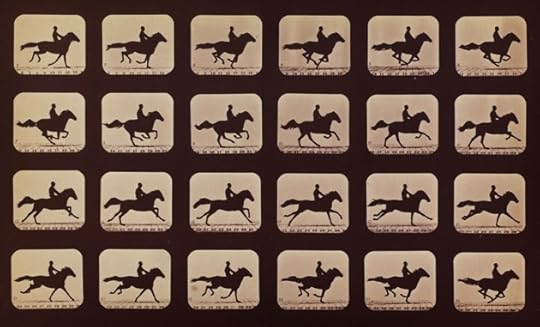
Eadweard Muybridge
In 1877, at a track in San Francisco, Muybridge strung a thread across the dirt at horse-chest height. It led to a trigger attached to his camera. Stanford had funded Muybridge’s work for years, and this was their most meaningful trial yet, so when Stanford’s horse trotted down the track at 40 feet per second, Muybridge was ready with his camera.
When Muybridge began his work with Stanford’s horses, photography had barely been around 50 years. The craft was so sensitive that a slight breeze on leaves in a landscape, or the shift of a neck in a portrait, could ruin a picture. A camera’s shutter speed determines how long it’s exposed to light, which means anything moving while it’s open can look blurred. Before Muybridge, photographers exposed light to the film by removing the lens cap with their hands, then jamming it back on. This is why most people in photos at the time look like zombie facsimiles of themselves, stiff with rigor mortis. But in the early 1870s, Muybridge invented mechanical shutters, a system that used a trigger and rubber springs to snap two planks shut in front of the lens at one-thousandth of a second.
The photo Muybridge took was completely disappointing—to Muybridge, at least. Yes, it pictured the horse with all four hooves off the ground, which was by no means a small achievement, because no one else in history had done this. A few newspapers ran the photo. But it was a single image. In order to understand motion, Muybridge needed to separate a movement into its parts, to slice the seconds that make a moment, then splice them back together with his photos. This would take another year.
He’d later say his first memory was waking up 150 miles away in Arkansas, to a doctor who told him he’d never fully recover.
At this time, Muybridge had spent just a little more than a decade as a serious photographer––he hadn’t even started in the medium until he was in his mid-30s. In 1855 when he first arrived in San Francisco, Muybridge owned a bookstore. On May 15, 1860, Muybridge ran an advertisement saying he’d sold his store and planned to travel for Europe. On his way, his stagecoach crashed in northeast Texas down a mountainside into a tree, smashing the stagecoach to pieces, and hurling Muybridge and seven other passengers into the rocky hillside. One man died. Muybridge hit his head so hard that for a while he lost his senses of taste and smell. He’d later say his first memory was waking up 150 miles away in Arkansas, with a doctor over him who said he’d never fully recover.
Muybridge spent about six years recuperating in England, and little is known about his time there. But after his return to the Bay Area in 1866 he quickly became a masterful photographer. He captured Yosemite National Park’s thousand-foot waterfalls and its vast granite mountains––photos that would later inspire Ansel Adams. He shot lighthouses. He photographed himself pretending to be a lumberjack, his legs spread wide as he looks up the trunk of an insurmountable redwood tree.
People obsessed over landscape photos at the time. The images represented the fierceness in American spirit that had settled the frontier, but with the ease of travel brought by train seemed already to have faded. Photographers tried to bring moments of that wildness back to cities as best they could. But while shutter speed could capture stationary lakes and mountains, the passing sky overhead looked like bland white sheets. To make scenes more convincing, photographers sometimes painted or superimposed clouds into their pictures. Muybridge, instead, invented the “sky shade.” This screen shielded the sun’s light enough to capture the landscape, but still rendered the sky’s tones. Now the people in East Coast cities could look into a photo and feel as if they stood in valleys of the Sierra Nevada Mountains, or atop granite peaks. Muybridge signed these photos under the name “Helios,” the Greek personification of the sun.
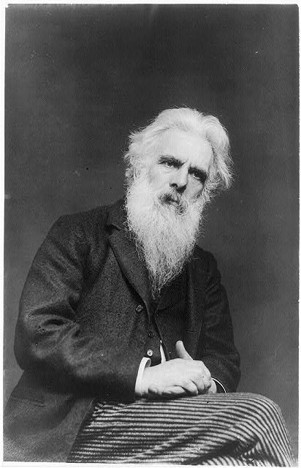
Eadweard Muybridge
Muybridge looked like a mix of Walt Whitman and Zeus. He was tall and lean, with a long white beard, and bushy brows that shadowed his eyes and made him seem thoughtful and deviant. In six years he’d already gained some fame for his landscape photos, and in 1871, while in his 40s, he married a woman half his age named Flora Shallcross Stone. One year later, Stanford telegraphed Muybridge about an idea he had to photograph his horses, and for three years Muybridge worked on the technology to do exactly that. That work stopped in October 1874, after Muybridge found a letter his wife had written to a drama critic named Major Harry Larkyns.
Muybridge found the letter in his midwife’s home. In it was a photograph of his seven-month old son, upon which his wife had written the boy’s name as “Little Harry,” which led Muybridge to believe his son was not in fact his son.
“He stamped on the floor and exhibited the wildest excitement,” Muybridge’s midwife remembered after he found the letter. “He was haggard and pale and his eyes glassy ... he trembled from head to foot and gasped for breath.”
Muybridge caught a train that afternoon north from San Francisco to Vallejo. It was night when he knocked on Larkyns’ door. As Larkyns stepped forward, Muybridge shoved a revolver at him and said, “I have brought a message from my wife, take it.”
Larkyns died from the gunshot. At trial, Muybridge pleaded insanity. Stanford hired a lawyer to defend him, and friends testified that the stagecoach crash had jarred something loose, had transformed a genial bookstore owner into an emotionally unmoored photographer. A friend and fellow photographer, William H. Rulofson, at trial said Muybridge sometimes slipped into bursts of grief or anger, and just as easily into a placid daze, “immovable as stone.” It’s hard to tell whether this personality change was real or a story conjured by a creative lawyer, but one theory about Muybridge’s injury is that it damaged his orbitofrontal cortex. If that is true, along with altering his emotions, it could explain why Muybridge became so possessed with his work.
Injuries to the orbitofrontal cortex are sometimes connected to obsessive-compulsive disorder, and it was through Muybridge's microscopic fixation on motion that his photos became art. He photographed birds flying, cats leaping, and the American bison galloping at a time when the nation had nearly hunted the animal to extinction. His obsession with all manners of motion drove him to capture women lifting bedsheets, raising cigarettes to their lips, or the quasi-absurd, like in his series Crossing brook on step-stones with fishing-pole and can.
The series consists of 36 pictures taken from three angles, and it follows a woman as she raises her leg, hops onto a stone, then another, then hops off, all the while she holds a fishing pole in one hand and a can in the other, her arms bent like the wings of a bird. Artist have used this work to study motion. Edgar Degas, himself obsessed with the movement of dancers, studied photos like it. As did Marcel Duchamp, particularly in his 1912 painting, Nude Descending a Staircase, No. 2, which became one of the most famous modernist paintings, and looks just like Muybridge’s photo series, Woman Walking Downstairs.
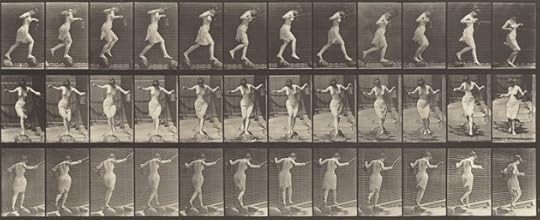
Eadweard Muybridge
Muybridge’s work at this time mimicked human curiosity. Machines had increasingly become part of life––trains, cars, and the factories of the Industrial Revolution––and soon people began to notice how their bodies resembled those machines. In Muybridge’s photos of the woman crossing the creek you can see her ankles, knees, shoulders, and elbows, rotating along their individual joints, but also in unison as her weight shifts to contract a muscle that pulls on one tendon and relaxes another, a repeating system of pulleys. This interested the University of Philadelphia for the potential insight it offered in the fields of sports, medicine, and physiology. It was there that Muybridge created more than 20,000 photos for his first book, Animal Locomotion. The Corcoran’s curator, Brookman, called the work a “veritable atlas of imagery about movement and time.”
The state charged Muybridge with murder for killing Larkyns. In closing arguments, Muybridge’s lawyer argued that “every fiber of a man's frame impels him to instant vengeance, and he will have it, if hell yawned before him the instant afterward.” The jury of mostly old and gray men seemed to agree, and the photographer was acquitted.
Muybridge and his wife divorced. She died five months later of an illness. And even though he’d given his son the middle name Helios—the same he signed his photos—he abandoned the child at an orphanage.
What’s certain in the pictures is that a horse in gallop looks nothing like any artist ever imagined.
In 1877, Muybridge was back working for Stanford. By now, the racetrack on Stanford’s ranch had a photo shed that housed a bank of dozens of cameras. On the other side was an angled white wall, and in between them Muybridge spread white powdered lime on the dirt so the horse would pop out as it raced toward the cameras. In June 1878, Muybridge greeted reporters and told them to prepare for, as one writer would recall, a photographic feat that marked “an era in art.” A series of wires ran from the angled wall every 21 inches to the shed where they pulled triggers connected to an electrical circuit. This was the complex technology Muybridge had worked with Stanford’s engineers to develop––unimaginable just five years before. When the horse ran down the track it would trip the wires, pull the trigger that closed the electrical circuit, and release rubber springs loaded at 100 pounds of pressure that snapped the shutters closed at one-thousandth of a second. The reporters at the racetrack that day waited. Then Stanford’s horse galloped down the track, tripping the cameras lines, one after another.
Muybridge developed the film in front of reporters so there’d be no doubt he’d taken them that day. In one photo series from these experiments, called Sallie Gardner at a Gallop, all four hooves of the horse clearly leave the ground in the first four of 16 photos. What’s certain in the pictures is that a horse in gallop looks nothing like any artist ever imagined. Stanford would later meet with the French artist Jean-Louis Ernest Meissonier––so famous at the time that The New York Times referred to him simply as, “the great artist Meissonier”––and asked him to draw a horse, then to draw that same horse in stride a foot later.
Dumfounded, Meissonier said, “I can’t do it.”
“And yet Meissonier many years ago drew the picture of a horse that would have irretrievably damned any other artist than himself,” the Times wrote.
Another reporter called Muybridge’s accomplishments with camera technology as important as the phonograph and the telephone. But Muybridge’s legacy today is not what he wanted. Beginning with his first single-frame photographs of galloping horses, Muybridge had worked toward recording sequences of movement using dozens of cameras as a way to pause and reanimate motion. Now, we’d call that film. One year after the reporters watched the horse snap the camera lines on Stanford’s ranch, Muybridge developed the zoopraxiscope, the precursor to cinema.

Eadweard Muybridge
The machine used a glass disc spun around a projection lantern, and when Muybridge showed his photos of horses to people in 1880 at an exhibit in San Francisco, one reporter wrote that “nothing was wanting but the clatter of the hoofs upon the turf and an occasional breath of steam from the nostrils.”
The animated images lasted only a few seconds, and looked uncannily like a GIF. It’s nearly impossibly to view Muybridge’s work through a zoopraxiscope today, but since many of his photos have been turned into GIFs we can again see Muybridge’s art as he did.
In his photo grids an action begins and ends. But in constant, repeated motion, the action spills into a circle of infinite movement, as if the two naked blacksmiths will pound that anvil forever, or the couple will waltz together long past midnight.
There’s something mesmerizing and voyeuristic about Muybridge’s photos as GIFs, because it reveals the world as we see it in passing, but not as we understand its parts. And that is what Muybridge tried to do all his life. So it’s today that Muybridge has come perhaps the closest to being remembered as he wanted to be remembered—as the creator of early cinema.
At the 1893 World’s Fair in Chicago, Muybridge planned to give 300 lectures in his Zoopraxigraphical Hall, discussing his life’s work. The fair featured other inventions like the debut of the original Ferris Wheel, and the inventions of Nikola Tesla and Thomas Edison, who were both locked in their own war to be immortalized. Muybridge’s exhibit was a complete flop. Other minds had advanced upon his zoopraxiscope, and in two years an audience in France would watch a 46-second projection shot by the Lumière brothers of women leaving a factory. It was the first public screening of cinema. It had been just 18 years since Muybridge’s horse experiments, and already his work was something to be displayed in museums. A small stone in a path toward something greater.
That he is largely remembered for his work capturing the motion of horses is somewhat tragic. He had pushed photography to its uttermost limit, willed it to do what he wished, until it became something entirely new. But for some 40,000 years, man had tried to understand the unseeable motion in those four legs of the horse. Da Vinci, Meissonier, everyone had failed. Then came Muybridge with his cameras. Suddenly the horse’s back legs swing up in neat lines at the joints, the front legs reach forward, then curl inward and upward to the belly, first the left, then the right. And for a moment, thanks to Muybridge, the horse is airborne.

July 23, 2016
The Clinton-Kaine Debut
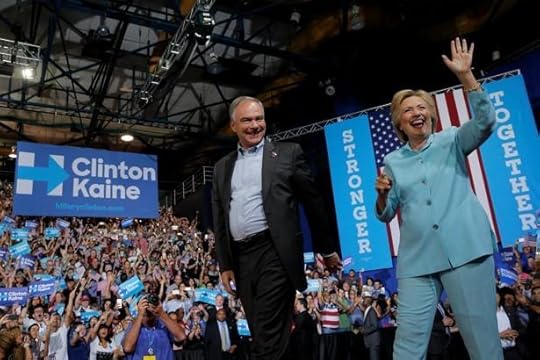
Now, the hard part.
In their first joint appearance as running mates, presumptive Democratic nominee Hillary Clinton pitched Virginia Senator Tim Kaine and herself as more positive alternatives to Donald Trump and the Republican Party he now controls.
The hour-long Saturday rally at Florida International University in Miami presented the Democratic ticket as an optimistic choice for America—a stark contrast with the angry, dark vision presented by Trump in Cleveland last Thursday.
“Donald Trump may think America’s in decline,” Clinton told the crowd, “but he’s wrong. America’s best days are still ahead of us, my friends.”
But the focus of the rally was Kaine himself, who made his second appearance with Clinton this month and his first since being selected as her running mate. To that end, the likely Democratic nominee spoke at length about Kaine’s character and fitness for office.
“The most important qualification when you are trying to make this really big choice is, ‘Can this person step up to be president?’” Clinton said. “Well, at every stage of Tim’s career, the people who know him best have voted to give him a promotion.”
Kaine, a largely centrist senator and former Virginia governor known for his affability, took the stage and began addressing the crowd in Spanish, a strong but symbolic contrast to the Republican candidate.
But Kaine also went after Trump in more direct terms, attacking his judgment and business record.
“From Atlantic City to his so-called university, he leaves a trail of broken promises and wrecked lives wherever he goes,” Kaine told the audience. “We can't afford to let him do the same thing to our country.”
Clinton also went on the attack. Responding to Trump’s “I alone can fix it” message during his acceptance speech on Thursday, she drew direct comparisons between her opponent and foreign “despots, dictators, [and] authoritarians.”
“We fought a revolution because we did not want one man making all the decisions for us,” she added, to cheers.
The rally largely served as the first introduction of Kaine to a national audience, one that precedes his primetime speech to the Democratic National Convention in Philadelphia on Wednesday.
Both Clinton and Kaine highlighted his biography and accomplishments: a legal career focusing on fair-housing cases, his time as a Catholic missionary in Honduras, and his “backbone of steel,” as Clinton phrased it, against the NRA after the Virginia Tech University shooting in 2007 when he was governor. When he spoke of the tragedy, emotion clouded his voice.
Clinton also described Kaine in terms she used to deflect criticism about her own centrism from Vermont Senator Bernie Sanders in the primary. “When I say he’s a progressive who likes to get things done, I mean it,” she said.
Kaine’s selection is unlikely to sway Sanders’s more left-leaning supporters, many of whom remain wary of Clinton. His past support of the Trans-Pacific Partnership and his more moderate approach to financial regulation are among the most common complaints.
But Clinton, perhaps aiming for party unity, also drew a sharp contrast between herself and her running mate versus their November opponents.
“Tim Kaine,” she said, “is everything that Donald Trump and Mike Pence are not.”

A Massive Bombing in Kabul

NEWS BRIEF Two explosions ripped through a protest in Kabul on Saturday, killing at least 61 people and wounding 207 others in one of the deadliest bombings to strike the Afghan capital since 2001.
ISIS claimed responsibility for the attack through Amaq, the organization’s de facto media arm, which said two bombers detonated suicide belts in the crowd.
Al Jazeera has more details:
Mohammad Ismail Kawoosi, a spokesman for the Afghan health ministry, warned that the death toll could rise further.
Graphic television footage from the site of the blasts showed many dead bodies lying on a bloodied road in Deh Mazang circle, close to where thousands of the Hazara had been demonstrating over the route of a planned multimillion dollar power line.
"I was in the crowd of protesters when a loud bang occurred nearby. Many people have been killed or injured - I am in deep shock," demonstration organiser Jawad Naji told the AFP news agency.
The blasts targeted a demonstration by the country’s Hazara ethnic minority, which makes up between 10 and 20 percent of Afghanistan’s population. According to the Guardian, protesters had gathered to demand the Afghan government divert a planned power-transmission line to Turkmenistan through two provinces with large Hazara communities.
ISIS-linked militias in Afghanistan control far less territory than their counterparts in Iraq and Syria. But its growth and resilience in some of the country’s rural provinces in recent years has drawn international concern. In January, President Obama authorized U.S. forces stationed in Afghanistan to launch offensives against ISIS militias. The Taliban has also vied with local ISIS militias for control of key towns and smuggling routes.

Absolutely Fabulous and the Curse of the Endless Party

The 1990s were something of a golden decade for portrayals of women segueing angstily into middle age, Smirnoff bottle in one hand, self-help book in the other. In 1995, CBS premiered Cybill, a zingy sitcom starring Cybill Shepherd as a twice-divorced actress facing the twilight of her mediocre Hollywood career with the help of her best friend Maryann (Christine Baranski), a fabulously wealthy, comically drunken divorcee. In 1996, Helen Fielding published Bridget Jones’s Diary, the first-person account of a hapless, luckless 30-something who subsists on Chardonnay, Marlboro Lights, and cheese while pratfalling from one public shaming to another. But before either of those, all the way back in 1992, there was Absolutely Fabulous.
The BBC sitcom started life as a skit called “Modern Mother and Daughter” on French and Saunders, a comedy sketch show, with Jennifer Saunders playing a middle-aged woman who acted like a teenager and Dawn French playing her teenage daughter, forced by her mother’s emotional and financial immaturity to be the grown up. This evolved into the first six-episode season of AbFab. It was written by Saunders, who played Edina Monsoon, a needy and pathologically shallow PR professional endlessly making a fool of herself alongside her best friend Patsy (Joanna Lumley), an impossibly glamorous fashion editor who also appeared to be an alcoholic and drug-addicted vagrant. Julia Sawalha now played Edina’s teenage daughter, a frumpy, stolid 16-year-old whose denunciations of her mother (“you’ve been getting dressed for three hours and you still look like a bloated citrus fruit”) became one of the highlights of the show.
At the core of Absolutely Fabulous was a paradox. On the one hand, the show skewered all the societal pressure on women to be desirable, fashionable, and, above all, young. On the other, its comedy was entirely based on audiences finding Edina pathetic, nasty, and redundant. The first-season episode “Fat” revolves around Eddy’s increasingly desperate and ridiculous attempts to lose a large amount of weight in a week; the same season featured “Birthday,” essentially a 30-minute tantrum thrown by Edina over the idea of turning 40. As the show continued, popping up only intermittently between 1996 and 2012 with revivals and Christmas specials and anniversary episodes, Edina only got older, and more desperate. The new film Absolutely Fabulous finds her facing 60 or thereabouts, still falling plastered out of taxis, and sadder than ever. All she ever wanted, she cries, is “to not be fat and old, and to keep the party going.”
The concept of aging incapably has been a recurring theme throughout Saunders’s career. Her earliest comedy act, with French, when the two were in their 20s, was called the Menopause Sisters. In 2001, a season-four episode of AbFab titled “Menopause” revolved around Edina facing career disgrace, Patsy being diagnosed with osteoporosis, and Saffron organizing a menopause support group meeting in Edina’s home to try and make the two face their future with dignity. “My name is Jobo, and I’m happy to be having the menopause, ” one woman declares. “I have hot flushes, and memory loss, and sometimes when I sneeze, I pee.” Patsy raises her hand and counters, “Patsy Stone, I hope you’re wearing thick underpants.” Edina furiously urges everyone to sit on black plastic trash bags so they won’t ruin the furniture. For more than two decades on the air, the show was clear: The prospect of getting old was hilariously mockable; the only thing funnier was refusing to do so.
Absolutely Fabulous the movie is no more substantial in plot than many of the show’s 30-minute episodes. Edina, facing career failure as usual and desperate to sign a new high-profile client, gets word from Patsy that Kate Moss is looking for a new PR person (English-speak for publicist). Edina and Patsy rush to a party where Moss is in attendance, but with her typical clumsiness and maladroit posturing, she accidentally pushes the supermodel into the River Thames. A festival of national mourning begins in Britain, and Edina is arrested for attempted murder. But worse for her than the prospect of going to prison is the fact that she’s suddenly a pariah, “fat and old and hated and nothing.”
At a party attended by London’s fashion glitterati, bystanders discuss the various anti-aging merits of toddler blood and fetus stem cells.
In its first 30 minutes or so, Absolutely Fabulous feels like a return to form. The physical comedy of watching Eddy and Patsy, absolutely trollied, tumble down staircases and fall on their faces is always funnier than it should be; meanwhile AbFab is sharper than ever on the vampiric nature of the quest for youth. Waking up, Patsy injects Botox into her face while Edina puts on her makeup. At a party attended by London’s fashion glitterati, bystanders discuss the various anti-aging merits of toddler blood and fetus stem cells. There’s an odd parade of cameos from It Girls, fashion industry names, actual stars, and C-list celebrities: Jourdan Dunn, Lulu, Emma Bunton, Stella McCartney, Gwendoline Christie (“it’s Brienne of Tarth!” Saffron’s daughter exclaims), Jerry Hall, Janette Tough (in one of the film’s more dubious moments, the white actress plays an Asian fashion designer), Jon Hamm, and the perpetual Christopher Biggins.
Then, things go awry. The direction, by Mandie Fletcher, lacks precision, and much of AbFab’s humor feels stuck in the 20th century—jokes about Edina’s granddaughter being more valuable to her because she’s mixed race, gags about having to be nice to transgender people now. Consumption is more conspicuous than ever. Although Edina is, by all accounts, a personal and professional catastrophe, she now lives in a cavernous West London mansion with an indoor pool that feels better suited to an oligarch laundering rubles. Eddy somehow manages to escape to the south of France with Patsy, her granddaughter Lola (Indeyarna Donaldson-Holness), and Lola’s credit card, and it’s there that both the movie and its stars are forced to face up to the reality of their circumstances.
One of the most striking scenes comes toward the end, when Eddy and Patsy attend a party on the French Riviera in search of a wealthy pornographer who once promised Patsy she was the only woman he’d ever marry. Inside a hotel, elderly women dance together, laughing, and having genteel fun. Outside, all the assembled men are on the terrace, frantically bobbing their heads to electronic dance music while a group of ravenous-looking Eastern European models prowls around them. Eddy and Patsy, too “young” for the first party, and far too old for the other, have nowhere to go. Society has sidelined them.
Writing for The Spectator recently, Tanya Gold criticized Absolutely Fabulous as a remarkably malicious portrait of female failure. “You never see Eddy doing anything functional,” she writes. “You see only the chaos that she lives in; the fear she has of herself; the self-disgust that is the comic engine of Ab Fab. Eddy loathes her body—its bumps, its excrescences, its leaks—with a terror and commitment which, while no doubt familiar to female viewers who turn to the Daily Mail for similar torment, is pitiless.”
I won’t spoil the movie’s ending, but its twist is surprisingly gratifying. After everything—almost 25 years worth of parties and excoriation and shame and hangovers and never feeling good enough or young enough or thin enough—Eddy and Patsy seem to finally find validation in unexpected quarters. There’s a too-neat, entertainment-mandated deus ex machina quality to it, but there’s also a sense that female friendship and support is what’s kept them going all these years. It would be a tidy way for Absolutely Fabulous to wrap up forever; a glimmer of grace and dignity for the two most degraded fashion victims culture has ever served up. But it won’t be the end, of course. Part of the joy and curse of being a woman aging disgracefully is that the party never stops.

Colbert's Comeback and Women's Voices: The Week in Pop-Culture Writing
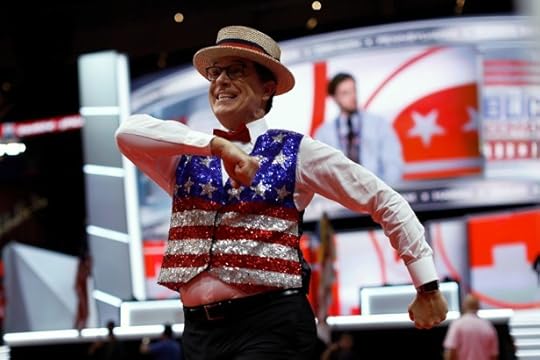
A Colbert Comeback On the Cards
Alison Herman | The Ringer
“Colbert’s incarnation of The Late Show has hardly specialized in the sort of bite-size segments whose digital afterlife increasingly stands in for late night’s cultural currency. In fact, it’s almost developed an identity in opposition to them, announcing itself in September with a heartfelt, two-part Joe Biden interview about grief and governance. The subtext seemed obvious: Keep your lip-syncs. This one is for the grown-ups.”
The Darker, Twisted Side of Roald Dahl
David L. Ulin | The New Yorker
“Such a posture of collaboration, of conversation, marks the bulk of Dahl’s fiction, whether for children or adults. It’s one of the pleasures of reading him, that for all the callowness, or cruelty, of his characters, he never extends his judgments onto us.”
The Cultural Anxiety Around What Women’s Voices Sound Like
Jordan Kisner | New York Magazine
“For every wrong-voiced woman, the nominal problem is excess. The voice is too something—too loud, nasal, breathy, honking, squeaky, matronly, whispered. It reveals too much of some identity, it overflows its bounds. The excess in turn points to what’s lacking: softness, power, humor, intellect, sexiness, seriousness, coolness, warmth. The fact that these adjectives come in relatively inverse pairs isn’t a coincidence.”
Jack Kerouac’s Eternal Photograph
Geoff Dyer | The Spectator
“Cohen’s picture of Kerouac tuning in to listen to himself on the radio captures not just a moment but the whole of the life; not just the man but the legend—and vice–versa. He’s listening to himself, to a record of his own achievement. It’s something every aspiring writer dreams of.”
How to Clean Up the Doping Mess
Silvia Camporesi, James Knuckles | Aeon
“Ultimately, the persistence of doping—by individuals on an isolated basis, and by whole teams as part of a systematic doping program—means that professional sport today is rarely—if ever—untainted. Many athletes have become little more than ‘guinea pigs’ in this system.”
Dave Eggers Returns With an Odyssey Across Alaska
Josephine Livingstone | The New Republic
“Eggers’s chief tools for inserting symbolic meaning into Josie’s chaos are children and pathetic fallacy. With this formal one-two punch, Eggers has somehow managed to mash the Victorian novel into the contemporary American family epic. Imagine Maggie Tulliver as the protagonist of The Corrections.”
Pokemon and the Addictive Cult of Cuteness
Sophie Knight | Foreign Policy
“What makes Pikachu and his friends so irresistible? The most basic answer is found in evolutionary psychology. When humans see something that resembles a baby—big eyes, large head, floppy or shortened limbs, a clumsy walk—it triggers a feeling of euphoria in the pleasure center of the brain (the same part of the brain, incidentally, that is stimulated by food, sex, and drugs like cocaine).”
The Street Art Movement: 1998-2008?
Raphael Schacter | Hyperallergic
“These artists were all moving away from the ubiquity of the spray-can (the technical basis of the period), utilizing media such as stencils or posters, producing forms such as sculptures or installations, methods that transformed the viewership of the practice from an exclusive to a more inclusive public. “
Some Useful Pointers on Visual Intelligence for Politicians
Kim Sajet | Smithsonian Magazine
“How colors, shapes, words, images and even sounds are communicated often has an historic antecedent deeply connected to human traditions that resonate today. When the Trump campaign referenced a six-pointed star, it wasn’t just the shape that caused offense, but the fact that it was in red, (warning!) and juxtaposed over a background wallpapered with money that harkened back to anti-Jewish propaganda of the 1930s.”

July 22, 2016
Munich Mall Shooting: What We Know

What we know:
—Nine people are dead and 10 injured in a shooting near a shopping center in Munich, Germany, local police said.
—Munich police also said a lone gunman, identified as an 18-year-old German of Iranian descent, is also dead after taking his own life.
—His motive, if any, is currently unknown, officials said.
—This is a developing story and we’re live-blogging the major updates. All updates are in Eastern Daylight Time (GMT -4).
8:59 p.m.
German authorities raised the death toll to 9 victims and one gunman, who they believe acted alone. The gunman, identified only as an 18-year-old German of Iranian descent by police, took his own life.
6:22 p.m.
Munich police say 10 people were injured in the attack; they previously said there were several injuries, but did not provide a number.
6:06 p.m.
Rukmini Callimachi, The New York Times reporter, is in Munich and is reporting on the story of one family that became separated after the attack. We’ll embed her tweets below:
4. Emotional, hard-to-watch scene at Krankenhaus Schwabing hospital. In the parking lot, a father with bloodshot eyes walks in circles
— Rukmini Callimachi (@rcallimachi) July 22, 2016
5. He explains that his teenage daughter & son were at the Olympic mall when shooting erupted. Daughter made it out. They can't find son
— Rukmini Callimachi (@rcallimachi) July 22, 2016
6. It's 4th hospital he's. gone to try to find his 17-year old son. In fact relatives know what happened. A cousin shows me pics on cell
— Rukmini Callimachi (@rcallimachi) July 22, 2016
7. She walks me away from father & flips through images showing teen lying in pool of blood. She hides phone when father approaches
— Rukmini Callimachi (@rcallimachi) July 22, 2016
8. Cousin has received images from scene showing boy was seriously hurt, if not killed. Not sharing with father bc he has a heart condition
— Rukmini Callimachi (@rcallimachi) July 22, 2016
9. We are in parking lot when ambulance arrives. Family rushes it. Inside is teenage daughter who survived. She emerges screaming/crying
— Rukmini Callimachi (@rcallimachi) July 22, 2016
10. Family hugs her tightly. Emergency workers have wrapped her in a white blanket, possibly because she's in shock. They lead her inside
— Rukmini Callimachi (@rcallimachi) July 22, 2016
6 p.m.
From the German Foreign Ministry:
#FMSteinmeier:horrified, thinking of the people in #Munich.It's good to know that we have our friends in Europe and the world behind us.#oez
— GermanForeignOffice (@GermanyDiplo) July 22, 2016
5:45 p.m.
Peter Altmaier, Chancellor Angela Merkel’s chief of staff, told ZDF television, that Merkel was being briefed on the developments and, “cabinet ministers concerned are on their way to Berlin.” Merkel will convene her security council Saturday to address the killings, he said.
5:41 p.m.
Donald Trump, the GOP presidential nominee, has a statement out:
Our prayers are with all those affected by the horrible attacks in Munich. This cannot continue. The rise of terrorism threatens the way of life for all civilized people, and we must do everything in our power to keep it from our shores.
5:09 p.m.
Special forces from Bavaria and other states, as well as the Federal Police, are taking part in the operation in Munich. Public transport and the electric rail-transit system are closed.
4:50 p.m.
Here’s more from Munich police:
We are verifying the possibility of one dead person being involved in the shooting, #München, #oez, #Schießerei
— Polizei München (@PolizeiMuenchen) July 22, 2016
4:39 p.m.
The police are saying there may be another ninth person killed, but it’s unclear if that person is an attacker.
4:28 p.m.
Munich police have raised the death toll in the shooting in the city to eight.
Eine traurige Nachricht: Die Zahl der Toten steigt auf 8.#Schießerei #oez #münchen
— Polizei München (@PolizeiMuenchen) July 22, 2016
4:15 p.m.
Hillary Clinton, the presumptive Democratic presidential nominee, said:
Monitoring the horrific situation in Munich. We stand with our friends in Germany as they work to bring those responsible to justice. -H
— Hillary Clinton (@HillaryClinton) July 22, 2016
She was scheduled Friday to name her running mate. It’s unclear if that will now happen today.
3:30 p.m.
Ned Price, a spokesman for the National Security Council, said Lisa Monaco, the president’s senior adviser, “apprised the president of the developing situation in Munich, Germany. The president will continue to be updated as the situation warrants.”
3:25 p.m.
We have new numbers from the Munich police: six dead and an unknown number of injuries.
[1/2] Update: #Schießerei #München #OEZ:
- unbekannte Zahl von Verletzten
- leider haben wir auch bereits 6 tote Personen zu verzeichnen!
— Polizei München (@PolizeiMuenchen) July 22, 2016
Only one crime scene has been confirmed, the department said in a separate tweet—at Hanauer Street, which adjacent to the shopping centre.
3:20 p.m.
President Obama said he is being updated on the unfolding situation in Munich, telling reporters before a meeting at the White House Friday that the U.S. will support Germany any way it can. More from the president:
We don’t yet know exactly what's happening there, but obviously our hearts go out to those who may have been injured. We are going to pledge all the support they may need.
3:01 p.m.
It’s worth noting that today is the five-year anniversary of attack in Norway by Anders Brevik, a neo-Nazi, who killed 77 people and wounded 319. Brevik is serving a 21-year prison term for his actions, the maximum allowed under Norwegian law. That sentence can be extended indefinitely.
2:59 p.m.
Several news organizations are reporting that Munich police are calling the incident an “acute terror attack.”
2:56 p.m.
Munich residents have started using the hashtag #OffeneTür or #OpenDoor to offer a place to stay for anyone trapped in the city because of the shooting.
2:44 p.m.
The German Interior Ministry confirmed to Deutsche Welle that at least three people were killed in the attack. Other news organizations are reporting a higher death toll.
2:35 p.m.
The U.S. Consulate in Munich has warned American citizens to “shelter in place.” Here’s more:
Review your personal security plans; remain aware of your surroundings, and monitor local news stations for updates. Maintain a high level of vigilance and take appropriate steps to enhance your personal security.
The U.K. Foreign Office, meanwhile, issued a similar warning to its citizens.
2:31 p.m.
Deutsche Welle reports the city of Munich has declared a state of emergency because of the shooting, asking residents not to leave their homes.
2:22 p.m.
The shopping center is near Munich’s Olympic Stadium. The city hosted the 1972 games, perhaps best known for the murder by Palestinian militant of 11 Israeli hostages.
2:13 p.m.
There are reports of more gunfire in Munich, police say.
Unconfirmed reports of more violence and possible #gunfire in the City Center. Situation is unclear. Please avoid public Areas. #munich #oez
— Polizei München (@PolizeiMuenchen) July 22, 2016
2:05 p.m.
Munich police, in a Facebook post, say there may have been three different shooters, none of whom are in custody. Police have yet to release official numbers of those injured or killed.
1:49 p.m.
Munich police have asked the public not to take photos of the shooting scene and publish them on the internet. “Do not support the culprit,” reads the police tweet.
Bitte keine Fotos/Filme von polizeilichen Maßnahmen online stellen. Unterstützt nicht die Täter! #oez #Schießerei #münchen
— Polizei München (@PolizeiMuenchen) July 22, 2016
Police say they are still searching for the person (or persons) responsible for the attack.
1:44 p.m.
A police spokeswoman, speaking with Deutsche Welle, said police believe they “are dealing with a shooting rampage,” as there may be more than one shooter involved.
1:30 p.m.
Facebook has initiated its safety-check in the wake of the reported shooting. The company has previously initiated the measure after the attacks in Nice and elsewhere.
1:24 p.m.
Munich police say several people were injured and told people to avoid public places. The situation, they said, is unclear.
1:20 p.m.
Munich city officials have shut down the city’s underground train network due to the shooting, Deutsche Welle reports.
1:07 p.m.
Munich police are asking people to avoid the area and stay in their homes.
12:59 p.m.
Casualties are being reported by Süddeutsche Zeitung, the major newspaper in Munich.
12:50 p.m.
Deutsche Welle, a German broadcaster, is reporting shots were fired at the Olympia Einkaufszentrum shopping center.
12:44 p.m.
Munich police say there’s an operation underway at a major mall in the German city.
Im Moment haben wir einen großen Polizeieinsatz am OEZ. Bitte meiden Sie den Bereich um das Einkaufszentrum.
— Polizei München (@PolizeiMuenchen) July 22, 2016
Friday’s operation comes just days after the attack on a German train in Bavaria, where Munich is also located. Monday’s attack, claimed by the Islamic State, injured four people. The circumstances of this operation are unknown.

Star Trek Beyond Is the Blockbuster America Needs Right Now

In these dark times, you might expect Star Trek Beyond to echo the tone of the previous film in this storied franchise, Star Trek Into Darkness. That was a paranoid thriller about suicide bombers, super-soldiers, and ethical rot at the heart of government—a decidedly dystopian tale. Happily, Beyond sweeps all of that aside, delivering a rollicking adventure about the transformative good of teamwork and unity that’s just as silly and enjoyable as that might sound. It’s no complex masterpiece, but it’s exactly the kind of fun steeped in effervescent goodwill that Hollywood should be delivering right now.
Like the two previous Star Trek films (which were directed by J.J. Abrams), Beyond stars Chris Pine, Zachary Quinto, Zoe Saldana, and others as younger, alternate versions of the original Enterprise crew, whose adventures tend to be a little heavier on the action beats and CGI mayhem than Gene Roddenberry’s original ’60s TV show. After making a royal mess of Into Darkness and moving on to the Star Wars franchise, Abrams handed the reins to the confident action director Justin Lin. Having revitalized the Fast & Furious franchise (directing the third, fourth, fifth, and sixth entries), Lin uses the same magic to spruce Star Trek up. Unlike Abrams’ sweeping 2009 reboot, Beyond can seem slight at times, but in a way that recalls the best of the franchise, harkening back to Roddenberry’s original, optimistic view of the future.
Some might scoff, but Lin’s time with Fast & Furious shines through even if the Enterprise crew is less muscle-bound. There’s a focus on squad unity, with Captain Kirk’s team thriving by acting as a surrogate family—one that always has fun and tosses out one-liners as the action clangs around them. Everyone is given at least a moment to shine: John Cho’s stoic family man Sulu, Karl Urban’s growling curmudgeon Bones, and the sadly departed Anton Yelchin’s endlessly enthusiastic Pavel Chekov. Beyond, written by its star Simon Pegg (who plays the irascible engineer Scotty) and Doug Jung, is rarely five minutes from an action scene, but it doesn’t get overwhelmed by the endless set-pieces. Its two-hour running time breezes by in a blur of day-glo adventure and derring-do.
It’s refreshing to see a blockbuster that has any kind of philosophy, especially one this good-hearted.
Beyond begins with Captain Kirk (Pine) bored by the generally utopian universe he lives in, shuttling through deep space on diplomatic missions for Starfleet and longing for some real action. He gets it quickly enough: Embarking on a rescue mission into a remote nebula, the Enterprise is attacked by a hive of alien ships, and crash lands on an uncharted planet ruled by a tyrant named Krall (Idris Elba). For most of the film, Krall is rather thinly sketched: Speaking guttural, halting English and mugging behind layers of scaly makeup, Elba can only do so much with the role, which doesn’t get much context until the film’s climax.
Still, he represents a basic threat to everything Kirk and company stand for, ranting about Starfleet’s emphasis on diplomacy and peace, and cursing their pathetic emphasis on solidarity. Meanwhile, the Enterprise crew, scattered to four corners of the planet by Krall’s assault, have to come together to stop him, making an alliance with another stranded alien warrior named Jaylah (Sofia Boutella). Pegg and Jung’s script is simple stuff, mostly avoiding the lovable ponderousness of past editions of Trek (there’s no Patrick Stewart reciting Melville and Tennyson, though Spock does at least slip in a Shakespeare line). Perhaps this reflects Hollywood’s current lows more than anything else, but it’s refreshing to see a blockbuster that has any kind of philosophy, especially one this good-hearted.
Best of all, just as he did with the Fast & Furious franchise, Lin never hits the audience over the head with the crew’s sweeping sense of diversity and the power they draw from their egoless camaraderie. Early on, as the crew takes some shore leave on a space station, you catch a sweet, subtle glimpse of Sulu embracing his husband and child; when Uhura is captured by Krall, she doesn’t need her boyfriend Spock’s help in escaping his clutches; and there’s a continuation of the brotherhood between Scotty and his three-foot engineering assistant Keenser, a beady-eyed, fungus-resembling creature who sneezes acid any time he has a cold.
Like the best Star Trek moments, the lessons learned are about embracing each other’s idiosyncrasies and banding together to fight for a common good. That’s the kind of message Hollywood blockbusters should promote more often, but it feels especially relevant to the present. When he created Star Trek 50 years ago, Roddenberry was hoping to reflect humanity’s best qualities in a paean to the future it could create for itself. It’s heartening to see Star Trek Beyond continuing that noble cause.

Atlantic Monthly Contributors's Blog
- Atlantic Monthly Contributors's profile
- 1 follower



